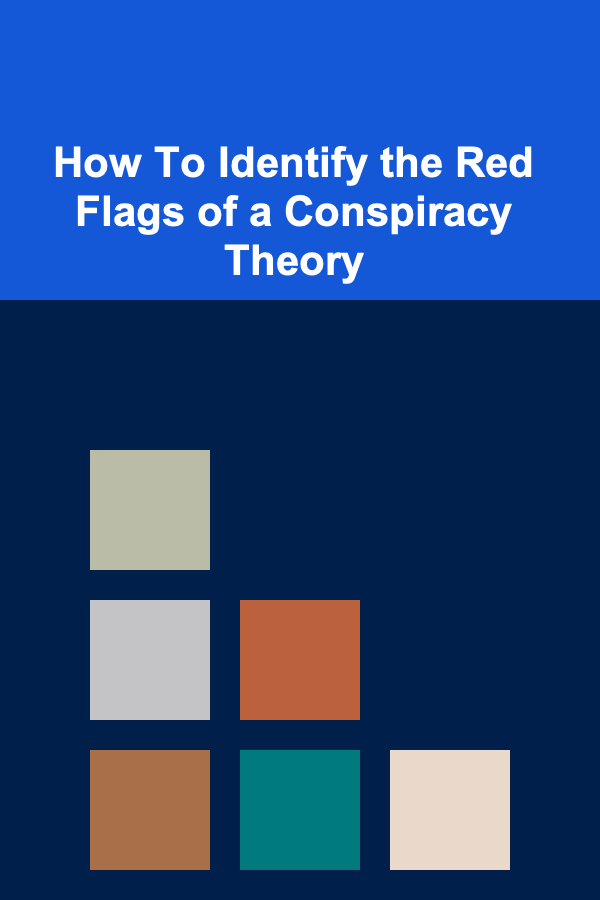
How To Identify the Red Flags of a Conspiracy Theory
ebook include PDF & Audio bundle (Micro Guide)
$12.99$7.99
Limited Time Offer! Order within the next:

In an era where misinformation spreads rapidly through social media and other channels, understanding how to identify the red flags of a conspiracy theory has become an essential skill. Conspiracy theories often promise hidden knowledge and reveal "truths" that the mainstream media or authority figures supposedly want to keep hidden. While some conspiracy theories are harmless, others can have dangerous consequences---affecting public health, politics, and society at large. This article will explore the ways in which we can identify conspiracy theories, the psychological and social factors that make them appealing, and practical steps to critically assess claims of conspiracy.
Understanding Conspiracy Theories
Before diving into how to identify the red flags of a conspiracy theory, it is essential to understand what conspiracy theories are. A conspiracy theory is an explanation of an event or situation that invokes a conspiracy by a group of actors, often with the implication that the conspiracy is being hidden from the public. These theories often involve the belief that powerful and influential people or organizations are manipulating events for their own benefit, without the knowledge or consent of the general population.
While many conspiracy theories have existed throughout history, the rise of the internet and social media has amplified their reach. This digital age allows people to find like-minded individuals who share their beliefs, reinforcing their convictions and often leading to echo chambers where alternative viewpoints are ignored or rejected.
Conspiracy theories can range from the relatively benign (e.g., the idea that certain historical events were staged) to the dangerous (e.g., denial of scientific facts like climate change or vaccination). What all conspiracy theories share is the element of suspicion and the belief in hidden agendas that are being concealed by "authorities."
The Appeal of Conspiracy Theories
Before identifying the red flags, it's important to understand why conspiracy theories are so appealing to many individuals. Several psychological and sociological factors contribute to the widespread attraction to conspiratorial thinking:
1. Cognitive Biases
Human cognition is riddled with biases that make us more susceptible to conspiracy theories. Some of the most common biases include:
- Confirmation Bias: The tendency to search for, interpret, and remember information that confirms pre-existing beliefs. People who believe in a conspiracy theory will often cherry-pick evidence that supports their view while dismissing evidence that contradicts it.
- Pattern Recognition: Our brains are wired to recognize patterns in the world around us. This can be beneficial, but it also leads to seeing connections where none exist. For example, when two seemingly unrelated events occur at the same time, a person may perceive a connection and interpret it as evidence of a conspiracy.
- Illusory Correlation: This refers to the tendency to believe that two unrelated events are connected. For example, after a tragedy or unexpected event, people might link it to the actions of a secretive group, even if there is no actual relationship.
2. Psychological Need for Control
Many conspiracy theories provide a sense of control over otherwise chaotic and uncertain circumstances. Life can feel unpredictable, and when events appear senseless or random, conspiracy theories offer a comforting illusion that things are not as they seem. Instead of accepting that the world is unpredictable, conspiracies provide a neat explanation, often placing the blame on identifiable figures or groups.
3. Group Identity
Conspiracy theories often create a sense of belonging for those who feel disconnected or marginalized by mainstream society. By adopting a conspiracy theory, individuals can feel part of an exclusive group that possesses "hidden knowledge" that others don't understand. This sense of exclusivity can reinforce beliefs and create a community of like-minded individuals who share the same worldview.
4. Distrust of Authority
Many conspiracy theories are rooted in a fundamental mistrust of authority---be it the government, mainstream media, scientific institutions, or any other power structure. For some, believing in a conspiracy theory is a way of questioning the established narrative and pushing back against perceived injustices. In a world where governments and institutions have been caught in lies or corruption, the inclination to believe that there are hidden agendas is strong.
Red Flags of a Conspiracy Theory
While not every conspiracy theory is harmful or completely false, the hallmark of a dangerous one is that it manipulates emotions, exploits fears, and distorts evidence to perpetuate its claims. To avoid falling into the trap of misinformation, it is essential to recognize the following red flags:
1. Lack of Verifiable Evidence
A central feature of conspiracy theories is the reliance on unverified or unverifiable evidence. They often present "facts" that cannot be independently corroborated by credible sources or scientific research. Claims may be based on anonymous sources, circumstantial evidence, or personal anecdotes rather than rigorous evidence or peer-reviewed studies.
Red Flag:
- Vague Sources: If a theory's claims come from unidentifiable or unverifiable sources, such as "insiders" or "whistleblowers" without credible backgrounds, it's a red flag.
- Absence of Credible Experts: Conspiracy theories often lack input from experts in relevant fields and instead rely on self-proclaimed authorities who are not trained in the subject matter.
2. Appeal to Emotion Rather than Logic
Conspiracy theories often play on emotional reactions, such as fear, anger, or distrust, to sway opinions rather than presenting logical arguments. They may exaggerate or sensationalize events to stir up emotional responses.
Red Flag:
- Exaggerated Claims: If the theory makes sensational or apocalyptic predictions without backing them up with hard evidence, it's a red flag.
- Us vs. Them Mentality: Conspiracy theories often pit "the good guys" (the theorists and their followers) against "the bad guys" (the conspirators), creating a black-and-white, us-versus-them narrative. This simplifies complex issues into dichotomies.
3. Overarching Explanations
Many conspiracy theories attempt to explain complex or tragic events with an overarching, simplistic narrative that fits all the facts into a predetermined story. These explanations often ignore contradictory evidence and overgeneralize.
Red Flag:
- One Size Fits All: The theory suggests that a single group or entity is responsible for a wide variety of unrelated events, often with little concrete evidence to support such a broad claim.
- Inability to Acknowledge Complexity: Complex issues or events, such as political unrest or pandemics, are simplified into a one-dimensional narrative that doesn't account for the many variables involved.
4. Disregard for Counter-Evidence
A hallmark of conspiracy theories is that they often reject any counter-evidence or contrary viewpoints as part of the conspiracy itself. Those who challenge the theory are often labeled as part of the conspiracy or as "agents of the enemy."
Red Flag:
- Dismissal of Expert Opinion: If experts in a particular field are consistently dismissed or ridiculed, especially when their evidence contradicts the theory, it's a red flag.
- Cognitive Dissonance: The theory often insists that any evidence against it is part of the cover-up, creating a situation where the theory is unfalsifiable.
5. Ad Hominem Attacks
Instead of engaging with the evidence, conspiracy theorists frequently engage in ad hominem attacks against individuals who criticize their theories. These attacks target the person rather than the argument, undermining their credibility without addressing the substance of their claims.
Red Flag:
- Personal Attacks: If critics of the theory are labeled as "shills," "puppets," or "part of the conspiracy," it indicates a refusal to engage with logical arguments and an unwillingness to critically examine the theory.
6. Circular Reasoning
Many conspiracy theories rely on circular reasoning, where the theory's premise is used to prove the theory itself. In essence, the claim is true because it says it's true, and any evidence to the contrary is explained away as part of the conspiracy.
Red Flag:
- Circular Logic: The theory supports itself by using its own claims as evidence. For example, claiming that all information from the mainstream media is false because it is part of the conspiracy, while using the same media sources to support the theory.
7. Misleading or Manipulated Data
Conspiracy theorists often manipulate data, charts, or historical events to fit their narrative. They may selectively quote from studies or historical events to mislead their audience, taking things out of context or misrepresenting facts.
Red Flag:
- Cherry-Picked Data: If a theory selectively uses data that supports its claims while ignoring or dismissing data that contradicts it, it's a red flag.
- Distorted or Outdated Sources: Claims based on outdated or discredited research are often presented as new "discoveries."
Conclusion
While the allure of conspiracy theories is strong, especially in a world filled with uncertainty, it is essential to approach claims critically and thoughtfully. Recognizing the red flags of conspiracy theories---such as a lack of verifiable evidence, emotional manipulation, and logical fallacies---can help individuals avoid falling prey to misinformation. The key to combating the spread of conspiracy theories is not only to identify them but also to promote critical thinking, media literacy, and open dialogue in society. In doing so, we can better navigate the complex landscape of information in the modern world and make more informed, rational decisions.

Developing Interactive Digital Flashcards: An Actionable Guide
Read More
How to Avoid Common Mistakes in Home Security Systems
Read More
How to Become a Travel Photographer: Turn Photography into an Income-Generating Side Hustle
Read More
How to Stage a Historic Home with Modern Touches
Read More
How to Handle Bureaucracy in a Foreign Country
Read More
How to Print Medical Models with 3D Printing: A Comprehensive Guide
Read MoreOther Products

Developing Interactive Digital Flashcards: An Actionable Guide
Read More
How to Avoid Common Mistakes in Home Security Systems
Read More
How to Become a Travel Photographer: Turn Photography into an Income-Generating Side Hustle
Read More
How to Stage a Historic Home with Modern Touches
Read More
How to Handle Bureaucracy in a Foreign Country
Read More